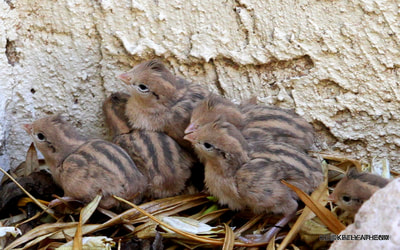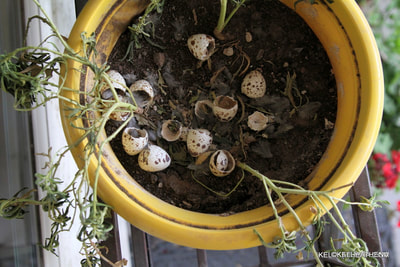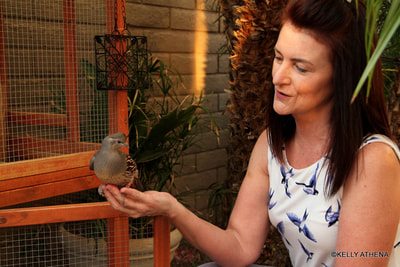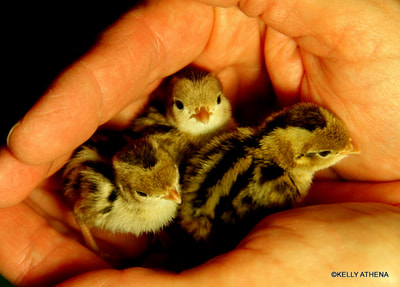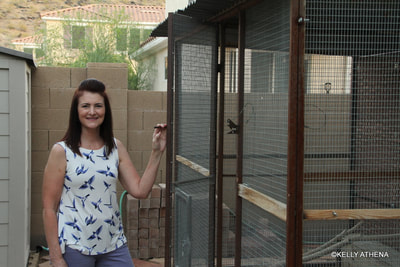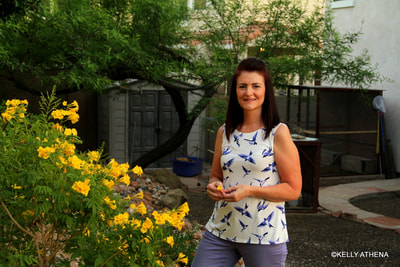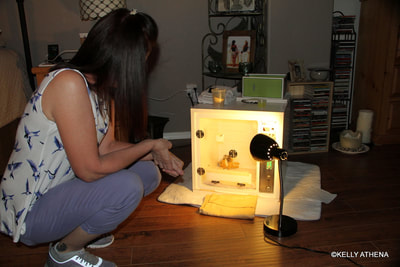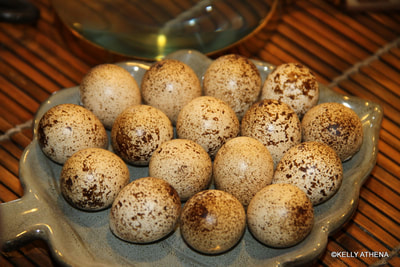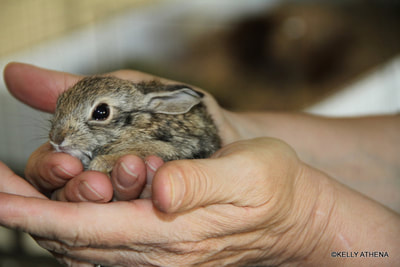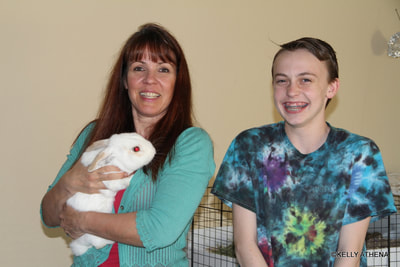Wildlife Rehab
|
Wildlife Rehabilitation
Front Page Article as it appeared in the Ahwatukee Foothills Newspaper here Hot Chicks Found in Ahwatukee by Kelly Athena Seven hot chicks on the road. One-hundred-ten degree asphalt nearly cooking them alive. They popped out of their eggs that morning and hit the ground running, but soon lost sight of mom and dad. Confused, lost, they waited on Desert Foothills Parkway for further instructions. Six sisters and one brother with one-inch tall, one-quarter ounce brown-and-tan-striped bodies wilting on the scorching pavement. Cheri Fromm was alerted and hurried over, scooping up their fuzzy ping pong ball-sized bodies into a container she brought. Within an hour she had rehydrated them. Their energy and health were restored. Another episode in the life of the founder of the Quail Sanctuary of Ahwatukee Foothills, known affectionately as the "Quail Lady." Cheri moved to Ahwatukee exactly twenty years ago this month. She sought out a large, bird-friendly lot. There she had her home built, with her back patio facing an inspiring view of South Mountain. She planted Yellow Bell bushes and Coral Fountain flowers to attract hummingbirds, and noticed the Gambel's Quail loved to munch the yellow flowers. After her three sons grew up and moved out of the nest, she missed their chatter and liveliness. She began volunteering at a local animal rehabilitation center, and a feeling of connection and fulfillment seeped into her life again. Cheri grew up in a beach house in Seattle. In spring time she and her family noticed the Mallard Ducks with their broods of ducklings paddling in the bay. Thirteen ducklings. The next day only eight ducklings. The next day they saw only five ducklings left. The sea gulls and occasional raccoon were feasting on the vulnerable ducklings while they were awkward and not yet waterproof. Cheri's mother talked her father into building a duck shed in their yard. Now when they saw newly hatched babies, they coaxed the mother into the shed and the babies would follow. Two weeks later they had grown bigger and faster, adept at staying close together. Cheri opened up the shed and the family emerged, no longer an easy catch for predators. As a teenager she often carried a duck or two in her Schwinn bicycle basket and became known as the "Duck Lady." Her mother thought she'd grow up to become a marine biologist. Instead she moved to the desert and began a career with the airlines. This year she has cared for over one hundred quail chicks so far. She also has a pet starling, Tango Loco, that likes to say, "Hello, crazy bird lady— I'm the most intelligent bird in the world!" He sings and whistles every jingle he hears on TV. Sleeping on top of Tango Loco's large cage is a juvenile grackle, recovering from a large pox on his face that Cheri successfully treated. Two more cages are brimming with the high energy of rescued lovebirds cuddling on their perches, squeaking to one another. Each is recovering from an injury. A couple feet away is a large cardboard box with netting on top. A brooder light shines down to warm six quail chicks. Five were brought to her yesterday after being trapped in someone's garage for two days, dehydrated and stressed. She rehydrated them subcutaneously. A sixth newborn arrived today after walking up on a hiker's foot in San Tan Valley. The hiker waited for more quails to appear, but they never did. She found Cheri's quail sanctuary online and arranged to bring the chick over immediately. Cheri's kitchen island looks like a doctor's supply station with syringes, bottles of antibiotics and steroids, bags of rehydrating liquid, and much more. A monthly calendar is filled with details of arriving birds with their condition, age, treatment, and an occasional triangle for a death. To tell the birds apart, she marks a certain color on the bottom of their right foot indicating the day they arrived. On the bottom of their left foot she uses a marker to indicate any medications she has given them. She has three dedicated helpers: Brenda, Jessica, and Allison. Her quails have a 91% recovery rate. Paul and Gloria Halesworth were wise mentors to Cheri when she began taking in quails. They took in ten thousand birds over the fifteen years they ran Wildwings Rehabilitation out of their Ahwatukee home. Hummingbirds were their specialty. They urge people to keep their hummingbird feeders clean by changing them every 2 or 3 days in the summer. "If there is any black mold in the feeder, it can cause the hummer's tongue to split. Some of them can be saved with antibiotics but it is a slow and painful process," said Paul. They urge people to take the feeder down if they're not going to be at home to clean the feeder often. "Make hummingbird formula with four parts water to one part white sugar. Boil the water and stir in the sugar until it dissolves. Then let it cool." The Halesworths still get calls from Liberty Wildlife and East Valley Wildlife to pick up large birds of prey that are found injured in the area. They are the only ones that know how to handle their sharp talons when transporting them. Another Ahwatukee animal rescuer is Denise Schaumloffel. She specializes in bunnies. She reminds us that the mother bunny comes only at dawn and dusk to nurse her babies, not wanting to draw the attention of predators. "If you find healthy baby bunnies hidden away in a little nest, please don't disturb them. They are not abandoned. And don't feed them milk--one drop will kill them!" Pam Horton specialized in pigeons and doves in her Lakewood neighborhood home for ten years. "I took in the common birds no one else had room for. I never turned an animal away." Arthritis has prevented her from caring for wildlife since 2015. Nancy Eilertsen of Chandler founded East Valley Wildlife in 1989. She organizes a network of wildlife rehabbers working out of their homes. There is no central facility. She often gets fifty to eighty calls a day during the busy season of March through August. "Volunteers juggle rehabbing with work and family obligations. Each handles different types of animals. Never leave an animal on a volunteer's doorstep. Between feral cats and the extreme heat, that animal won't have much of a chance." Nancy got involved with wildlife rehabilitation after finding an injured duck and bringing it to Liberty Wildlife. "I volunteered with Liberty for a year and then started East Valley Wildlife as there were no organized options in the southeast valley for rescued wildlife at that time. I got my state and federal licenses. Another volunteer and I started giving classes in 1990 and slowly found more people interested in helping out. We used to have sixty volunteers, but many moved away, retired, or went back to work full time, and we're down to about twenty-five." "The most important job a wildlife rehabilitation center can do is to teach the public to understand and respect wildlife." As monsoon season starts up, Cheri will get large amounts of chicks due to interrupted hatches caused by storms. The mother quail lays eggs over several days. Because it's so hot, the eggs start incubating before all the eggs have been laid. The later eggs cannot catch up in development. Even after the mom has left the nest (which may be a flower pot or spot on the ground) and taken the hatched chicks, the summer heat continues to incubate the abandoned eggs. The remaining chicks that hatch are born orphaned. Please contact Cheri if you see any abandoned eggs or chicks. Don't let them sit in a flower pot for days (as happened in four different cases last week)! And what happened to the seven hot chicks Cheri rescued from the scorching pavement? To her great joy, Cheri released the now twelve-week-old mature quail back into the wild—strong, healthy, and ready to face anything. Sidebar: If you see a baby bird you think is injured or abandoned: 1. Watch the baby bird for at least ten minutes to make sure it truly is abandoned. The parents may be nearby. Touching a baby bird does NOT make the parents reject it. 2. If you determine the bird is abandoned, resist your feeling to give the bird food or water which is often a fatal move. Instead, concentrate on keeping it warm by placing it in a shoebox with a heating pad set to medium under it. Make two pencil sized holes in the box, place the lid on it, and keep it in a dark and quiet room or garage. They must be kept around 99 degrees. They will die in an air-conditioned house without being warmed. 3. Fight your instinct to keep it as a pet. The longer it stays with you, the lower its survival rate. Four ten-day-old quail were brought to Cheri this week with severe rickets because a woman kept them as "pets" and fed them only wild bird seed. 4. Immediately contact East Valley Wildlife at 480-814-9339 or [email protected]. Go to http://eastvalleywildlife.org for detailed directions on what to do with the rescued animal. If it is a quail chick, go to The Quail Sanctuary of Ahwatukee Foothills on Facebook for contact information and instructions. Important tips you can take to help wildlife in your yard: 5. Consider putting a bowl of water in your yard to help birds survive in the extreme heat. Put it in a shady place with plenty of low plants around it. Put some sand, pebbles, and sticks in it so chicks won't drown. Make sure to refill it daily with hose water. If you have a cat or dog, put the bowl high out of the pet's reach. 6. Donations may be made online at eastvalleywildlife.org. The rehabbers pay for a lot of the supplies themselves and could use your gifts. 7. Please don't trim your trees between March and June, the peak nesting season. Wait until the second half of the year. Ask your landscaper to watch for nests and not to trim in any nest areas he finds. (Owls and lovebirds often nest in palm trees. Trim only brown, dead fronds. Trimming any green fronds weakens the tree and creates havoc for birds.) Quail need thick vegetation at ground level to survive. Consider letting your bushes grow naturally rather than shaping them into squares and circles. 8. Please don't let your cat roam, especially during the nesting season of March through June. If you find a bird that has been caught by a cat or dog, please inform the rehabber so they can treat for that. The pet's saliva will cause the baby to die without antibiotic treatment. 9. If you place a bird feeder near a window, please put small decals on the windows so birds will not fly into them. Bring in the leftovers at dusk to prevent attracting rodents, racoons, bugs, and coyotes. Birds love watermelon slices and other juicy, ripe fruits. Never put out meat for animals. It is illegal to feed any animals except birds. 10. Please don't use rat poison. Owls and other birds that eat a poisoned rat will die. Use an electric rat zapper. Don't use mouse traps unless it is housed in a soda can box with openings on the sides only. Traps out in the open often kill birds. Sticky mouse traps are meant to be used only indoors in a hidden place like under the stove or behind the fridge. If a bird does get stuck in one, please call E.V. Wildlife and don't try to pull the bird off of the sticky trap. Kill scorpions in your yard individually if you must, but avoid general insecticides and pesticides which indiscriminately kill bees and birds and pollute our groundwater. Note: If you see abandoned quail eggs or chicks, get them into a box within a few minutes and call Cheri at the Quail Sanctuary of Ahwatukee Foothills at 602-628-8175. ---------------------------- Kelly Athena is a master gardener, garage sale enthusiast, and sustainability writer. For more details about this article, please see http://kellyathena.com. Contact [email protected] with any sustainability stories. |
|
